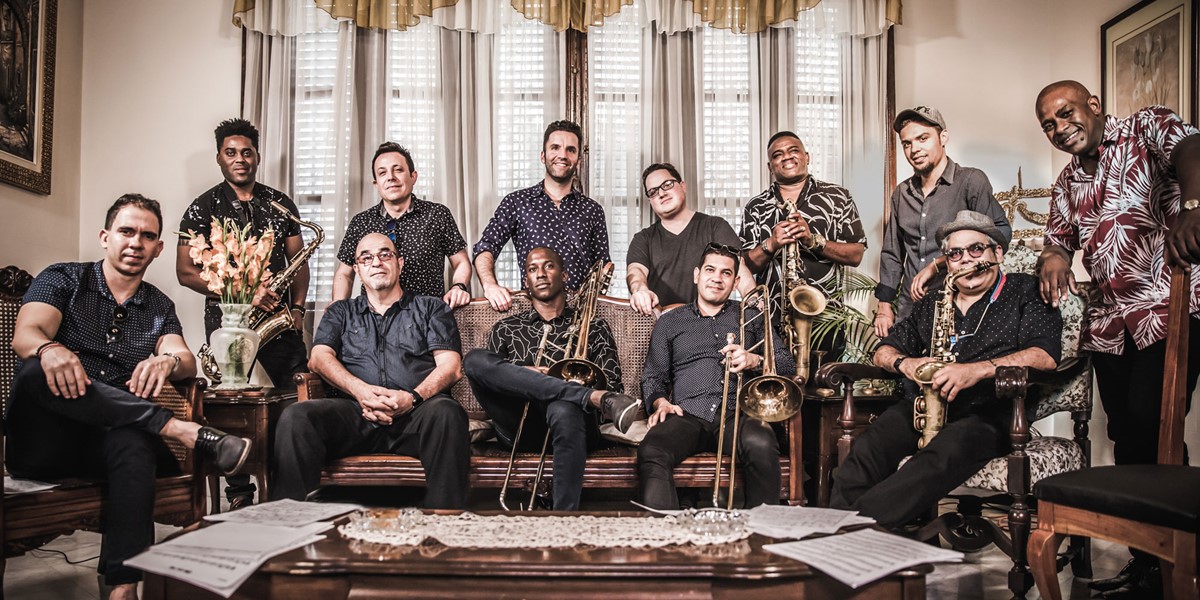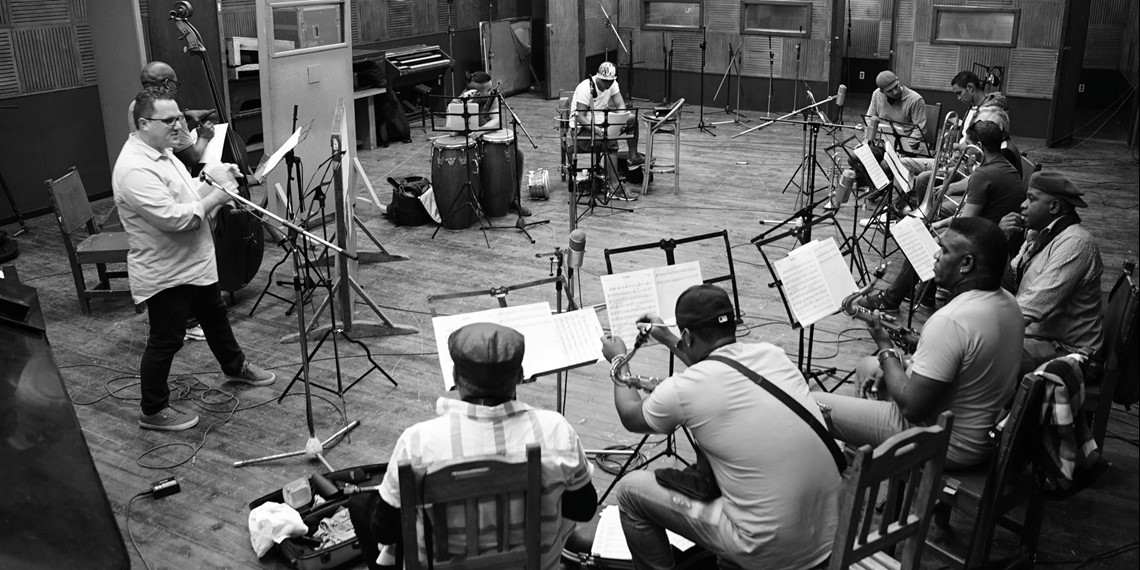Monday, November 25, 2019
Orquesta Akokán: “If you went to a music industry person with this idea, some marketing asshole in New York… forget it”
By Kim Burton
A new Cuban big band are making waves. All the more surprising for the fact that Orquesta Akokán are a collaboration of first-class Cuban and American musicians. Kim Burton tells their story so far

Orquesta Akokán (photo: Adrien H Tillmann)
“Before we went there to make a big band record, I talked to some people at home, and the response was: ‘Don’t do this, this is a terrible idea. It’s not going to work. Making a record in Cuba – it’s like the Bermuda Triangle; there are stories of shipwrecks and disasters’. But I said, well, OK, this might not work, but if it does I’m sure it’ll be pretty cool. Even when we got there, the Cubans were, like, ‘What are these guys doing? What are these dudes, blanquitos from New York doing down here?’ There were a couple of moments when even I was thinking this is a crazy idea, but luckily it worked out. By the end of it we were all chums.”
Jacob Plasse is talking about the debut recording on Daptone Records, made in Havana by Orquesta Akokán, a collaboration between US and Cuban musicians – and a labour of love that has become a surprise success, among other things winning the band a Songlines Music Award. With its commanding vocals, rolling saxophone section ostinati, solid mambo grooves and sudden solo flights of fancy from piano, flute and trumpet, it’s an extraordinary achievement that reconstructs the acoustic space of the Cuban big-band sound of the 1940s while remaining firmly rooted in the 21st century. Plasse, one of the triumvirate of New Yorkers who provide the driving force behind the band, explains how he grew to love and perform Latin music, and how he, pianist and arranger Michael Eckroth, and Cuban-born singer and composer José ‘Pepito’ Gómez, came up with their seemingly quixotic plan to record their new-old songs in the historic Areito studio in the heart of Central Havana, where practically every Cuban musician of note, from Beny Moré onwards, has recorded, including the Buena Vista Social Club over 30 years ago.

Orquesta Akokán in the studio (photo: Joel Pront)
“I grew up in New York so Latin music was always around, but it was when I heard a live show in a park by pianist and bandleader Eddie Palmieri that I was really hooked,” says Plasse. “I started as a guitarist, but I met Nelson González, who is a master of the tres, [the three-course, guitar-like instrument whose ostinato lines are the backbone of Cuban son], and he told me that if I wanted to play Latin music properly, then I needed to play tres, and he encouraged me to go to Cuba. He was my mentor, you might say. So I went and studied in Havana and Guantánamo, where it was a lot different to the way it is now. But it was fascinating. There were so many people who would speak to you about what was going on in the music – you know how the music is somehow so simple and incredibly complex at the same time, and the more you study, the more you realise how little you know. So I came back to New York excited, realised I still kind of sucked, and I kept practising.”
After graduating from college, Plasse played Cuban music in New York in a band called Los Hacheros where he met pianist Mike Eckroth. “Mike knows a lot about early piano styles and arrangements so we were able to geek out together.” Plasse and Eckroth’s shared love of the greats of the past – Arsenio Rodríguez, Beny Moré, Perez Prado and Roberto Faz – led them to examine what it was that made their recordings special.
“Take an old Beny Moré record. They had one or two mics, maybe four; but there’s something there, an energy that doesn’t exist on record these days. I realised that in Latin music what’s important is getting people together in a room; everyone plays together, everyone can hear one another and everyone’s interacting and you hear the sound of air moving in a room. So when we were making this record, the plan was let people play, keep out of the way, give them some direction, but not be micro-managing mic positions or mistakes or timing, because no one hears those things in the larger picture. Instead they create the feeling in the listener that this is a band playing rather than a bunch of guys playing to a click.”
The catalyst for forming Akokán was meeting the band’s singer, José ‘Pepito’ Gómez, who had moved to New York in 2005. He’d recorded with Plasse’s favourite timba band, Pupy Pedroso y Los Que Son Son, so Plasse felt pretty much in awe to be playing with him.
“José could have stayed in Cuba and been a star there, but he came to New York and wanted to know more about the world. Cuba is pretty isolated and he wanted to develop as an artist. And that translated to this project, since Mike and I had been thinking about making a mambo record, and I introduced Mike to him and then we tried to record some stuff in New York, but we felt it wasn’t really working. Then, fortuitously, José said he was going out to Havana for the 15th anniversary concert of Los Que Son Son. So he suggested we go to Cuba and hang out. Then he simply said maybe we should just try recording some songs there, and eventually we were in the studio in Havana with César López, the sax player from Irakere, and all these incredible musicians. It was really amazing having César involved because he’s not just an internationally renowned musician but a very kind person, and he knows everyone. In Cuba it can be very hard to get anything done sometimes. He makes it happen – the doors open and you’re able to do things. César and Pepito were absolutely central to finding the musicians and making it happen.”
Cuba’s musical education system is thorough, rigorous and comprehensive. Most musicians study at the Escuela Nacional de Arte (La ENA) and, provided they pass their exams and receive certification (or in the case of more folkloric instruments, pass a demanding audition), they are offered work by the state. All are trained in both classical and popular forms, so that members of a dance band might have met while playing together in a chamber orchestra, or vice versa. Plasse explains what this meant for the cohesion of the group:
“Cubans really value playing in sections, because there are a lot of big bands. There are large horn sections as opposed to New York, where there aren’t so many opportunities to play in a big band and things are geared more towards turning up, reading the charts, and playing a bad-ass solo. What really made this record happen was these guys’ ability to phrase and breathe together. What’s more, the younger musicians actually studied with the older ones; they taught them at La ENA, so the younger guys have respect for them; they talk to one another and it’s like they’re still learning from these guys. It creates a nice atmosphere when you’re on the road.”
But getting on the road might not have been so simple. After all, the relationship between Cuba and the US – although intimate – has not always been a happy one. For the US, Cuba has been a source of raw materials, cheap labour, a mafia playground, an ideological threat. For Cuba the US has been a promised land, an overbearing neighbour, a base for invasion and destabilisation. Yet Cuba’s contribution to US culture has been enormous – popular music would be very different without the overwhelming influence of the intense experimentation that emerged from Cuba’s musical laboratory over the last couple of centuries. Even the slight political rapprochement of the last few years, with President Obama visiting in 2016, is being violently wrenched into reverse by the current US administration. This makes it all the more remarkable that Americans and Cubans have been able to co-operate so deeply, with an American and European tour under way, bound together by a shared love of the music of the past. The respect for tradition is loud and clear.
But it’s also obvious that Akokán’s commitment to understanding and invoking the energy, richness and sheer sonic thrill of the old masters is tempered by an awareness that the world has changed, and musical languages have changed too. For instance, the record’s closing track ‘A Gozar la Vida’, in which an arrangement that could almost be mistaken for a classic track from the 50s, is followed by an angular, post-bop postlude of brass chords and jet-stream sax solo.
“It was one of things that we added while we were in the studio. Our idea was to figure out a way that we can expand things in subtle ways; not so that it would disrupt the feeling of the song or ruin the experience of it, but just – where could these harmonies go? They wouldn’t necessarily work back then, but if these guys were alive now and listening to Albert Ayler, what would they do? Our idea was not to imitate, but be inspired, and use the basis of Cuban music to explore further. I wanted to figure out a way that we could incorporate more contemporary things, without being too obvious about it. We wanted to find things that were complementary to that earlier style, to use ideas that were cool and would work within that style.”
Akokán is a Yoruba word meaning ‘From the Heart’ and the name feels apposite as a love for the music is what seems to have made everything work. “It’s a real band – it’s working and it’s getting recognised,” says Plasse. “It’s quite a surprise. Because if you went to a music industry person with this idea, some marketing asshole in New York… forget it. We all did this because we really loved the music, and I think that comes through, when everyone is passionate about doing a project for art’s sake rather than just trying to make a buck. Windfalls in the music industry are few and far between so you might as well just do what you love.”
This article originally appeared in the August/September 2019 issue of Songlines. Never miss an issue – subscribe today!

